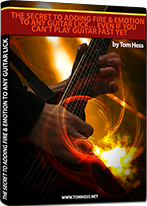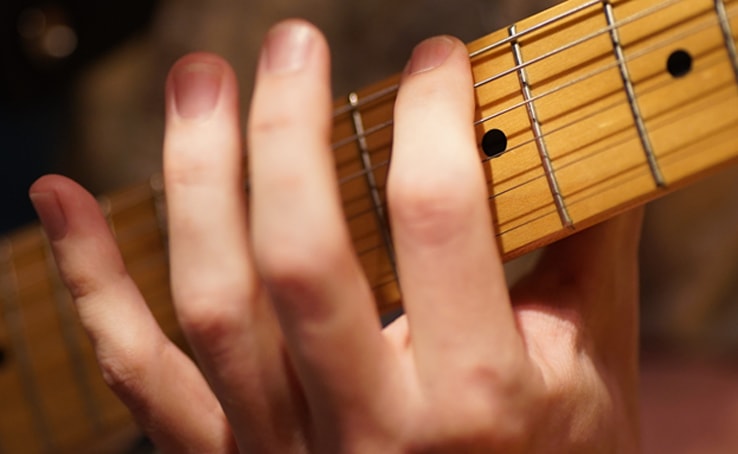How To Use Syncopation To Play Better Guitar Solos
by Tom Hess
Emotion To Any Guitar Lick

EMAIL TO GET ACCESS
By submitting your info, you agree to send it to Tom Hess Music Corporation who will process and use it according to their privacy policy.
Want to add more emotion to your guitar licks and solos?
This lead guitar article (and the video you’re about to see) will help you do just that.
Here is the story:
When I was learning to play lead guitar, I developed good guitar technique and learned many scales.
The problem?
When I tried to play guitar solos, my guitar licks seemed to lack fire and emotion.
No matter what I tried, I couldn’t seem to express emotion when I played guitar.
Emotion To Any Guitar Lick

EMAIL TO GET ACCESS
By submitting your info, you agree to send it to Tom Hess Music Corporation who will process and use it according to their privacy policy.
“Do you always play your guitar licks starting on the downbeat?”
This question helped me uncover the reason my guitar solos lacked feeling and why I struggled to express emotion.
And today, I teach you one of the best lead guitar tools for injecting emotion into your guitar playing:
Syncopation
It’s a very simple lead guitar technique that you can use to express emotion in your guitar licks even if you are not an advanced lead guitar player yet.
Here is how to practice the syncopation ideas you just heard & make it easier to express emotion in your guitar licks:
1. Practice syncopation on just one lead guitar note.
Yes, you can have guitar licks that consist of only 1 note, no more.
But here is the trick:
When you play your lead guitar note, milk it for as long as you can, using the syncopation techniques you just saw.
Play the note, mute it and then accent it again. Do it many times (like you saw in the video). This is how you express emotion with one lead guitar note.
2. When the basic lead guitar syncopation idea becomes easy, create longer guitar licks (and flesh out entire guitar solos) using 2 lead guitar notes.
With 2 notes, it becomes even easier to express emotion because the number of lead guitar licks you can create goes up exponentially.
Finally, start using longer guitar licks (of 3 notes or more).
Advanced Lead Guitar Tip: avoid overusing syncopation in your guitar solos.
Remember: the purpose of syncopation is to help you express emotion. And part of what lets you express emotion with syncopation is how unpredictable it sounds.
(In some ways, syncopation is similar to rubato.)
If listeners expect syncopation on all your guitar licks (and in every one of your guitar solos), then your lead guitar playing becomes highly predictable. When this happens - your ability to express emotion goes way down.
More about syncopation:
Even though syncopation is a very simple lead guitar idea…
…there are a few guitar technique elements you need to master to make it sound great:
Lead Guitar Element #1: String Noise Control
Like it or not…
…to play guitar licks (and guitar solos) that express emotion, you better be able to mute string noise in your lead guitar playing.
Without this, even the best lead guitar techniques will sound sloppy. And sloppy playing doesn't express emotion.
The best lead guitar techniques for muting string noise are: thumb muting and fretting hand index finger muting.
Each one helps you play cleaner and more expressive guitar licks and guitar solos.
Let’s explore each one in detail:
Thumb Muting: As the name implies, you simply rest your picking hand’s thumb on the lower (in pitch) string when you play guitar licks.
When your thumb is in position, slide it up and down the strings as you play lead guitar.
What does that accomplish?
Your thumb keeps the lower (in pitch) strings quiet when you play lead guitar.
This makes your guitar solos sound very clean and makes it easier to express emotion in your guitar licks.
You can also use your thumb to kill the lead guitar note when you are adding syncopation to it.
Want to see how it’s done on video? Watch this tutorial that covers thumb muting in detail:
Common Lead Guitar Question: “Tom Hess, I try to do thumb muting, but all I hear are pinch harmonics! How can I fix this and make my guitar licks sound clean?”
Answer: If you hear pinch harmonics, it means you are holding the guitar pick wrong.
Most people hold the guitar pick on the side of their index finger (and let the thumb hang over the edge of the pick).
This makes thumb muting impossible and many lead guitar techniques (like syncopation) become hard to play.
The result: you become less free to express emotion in your music.
The solution?
Change the way you hold the guitar pick. Slide your thumb back so it does not hang over the edge of the pick.
And hold your pick between the fingerprint of the index finger and thumb. (Same way you’d hold it when picking up a pen.)
This lets you do thumb muting easily, makes your guitar licks and guitar solos sound clean and lets you control every note you play.
And with this control comes greater ability to express emotion in your lead guitar playing.
Common Lead Guitar Question: “Tom Hess, which lead guitar technique is better for muting string noise: thumb muting or muting with my palm?”
Answer: Thumb muting is better. Here is why:
For one thing, thumb muting was specifically designed for muting lead guitar string noise (from the strings you are not playing in your guitar licks).
Palm muting is intended for muting the notes you are playing.
Second: the flesh of your palm is a lot softer than that of your thumb. That means it takes a moment longer for your palm to mute notes compared to your thumb. The result? There is more opportunity for string noise to happen – making it hard for you to express emotion in your guitar solos.
Next up, we have…
Fretting Hand Index Finger Muting: this technique helps you mute the noise on higher (in pitch) strings when you play lead guitar licks in your guitar solos.
Here is what it looks like:
Combine index finger fretting hand muting with picking hand thumb muting and guitar becomes fully in your control – letting you express emotion with every note.
Lead Guitar Element #2: String Bends
Everybody knows that string bends make it easy to express emotion in your guitar solos.
And when you combine syncopation with soulful string bends in your guitar licks…
…this makes your guitar solos express emotion that much better!
Plus: syncopation often sounds best when you do it in the context of string bends.
Here is why:
When you use string bends to express emotion in a guitar lick, the listener expects the bend to continue without stopping. Syncopation breaks up the arc of a string bend and surprises your listeners.
Let’s talk about how to do string bends the right way.
The most important element of great lead guitar string bending is:
Bending the strings in tune!
To make sure your string bends are always in tune, do this:
1. Play the note you intend to bend up to (as a regular note). For example: play the B string 10th fret. Get the sound of the 10th fret in your ear.
2. Bend the B string from the 8th fret up to the 10th fret. Stop when the bend matches the note you just played in the previous step.
Repeat these steps as necessary to make your bends more consistent.
Bonus string bending tip 1: Wrap your thumb around the neck of the guitar to bend strings. This gives your hand more leverage to do wider bends (wider bends are a great tool for expressing emotion in your guitar licks).
Bonus string bending tip 2: Rotate your entire arm using a doorknob motion. This makes it easy to bend strings without much effort.
Bonus string bending tip 3: Use thumb muting to keep your string bends clean.
Watch this video to see how to make lead guitar string bends sound great:
Lead Guitar Element #3: Vibrato
Your vibrato is the heart and soul of your lead guitar playing. And it’s the single best way you can express emotion in your guitar licks and guitar solos.
The better you vibrato is, the better you sound (even if you aren’t playing any fast guitar licks in your guitar solos). On the flipside, when your vibrato is weak, you’ll never express emotion in a strong way.
Great vibrato comes down to balancing 2 critical elements:
- its speed and
- its width.
Make your vibrato too fast and narrow and your guitar licks will sound nervous and out of control.
But if your vibrato sounds slow and wide? Then it no longer sounds like vibrato and sounds like slow bends instead.
Neither sound is good.
Here is the general guideline for how to assess your vibrato:
The faster your vibrato becomes, the wider it should be to sound good. (I personally like to use wide and fast vibrato to express emotion in my guitar solos.)
And the slower it is, the narrower it should be.
Tip: practice vibrato with a metronome to make sure it stays in sync with the beat.
Do vibrato in 8th notes, 16th notes and 8th note triplets.
When you get good at this, you’ll be able to make your vibrato sync up with any song you are playing.
And that is a sign of true vibrato mastery.
Watch this video to see what I mean:
Tip: the single best way to refine your vibrato is to transcribe vocal parts of great singers (and turn them into guitar licks for your guitar solos).
Few people can express emotion with 1 note like great singers can.
Spend 10-20 minutes per day of your lead guitar practice time transcribing vocal parts and mimic the singers’ vibrato nuances. This helps you express emotion with your lead guitar playing more than any guitar-specific exercise you can do.
Avoid These Common Vibrato Mistakes That Make It Hard To Express Emotion In Your Guitar Licks & Guitar Solos
Mistake #1: Out-of-tune vibrato. This vibrato makes your guitar licks sound awful. It happens when you don’t release the lead guitar note you just played all the way back to the starting pitch.
Pay attention to this when you practice vibrato and make its intonation consistent when you play guitar licks in your guitar solos.
Mistake #2: Inconsistent vibrato. This happens when you start doing vibrato at one speed and then make it faster or slower. (Guitar players often speed up their lead guitar vibrato as they lose control over it.)
Being aware of these lead guitar mistakes helps you refine your vibrato and play better guitar licks and guitar solos.
Lead Guitar Element #4: Delayed Resolution
Delayed resolution is a great way to express emotion with every note you play on guitar.
What you do is: set up an expectation for your lead guitar lick to resolve a certain way (and at a certain time)…
… but then you delay the resolution of the idea you created.
It’s a fantastic way to build tension with your lead guitar playing and express emotion with all your guitar licks and solos.
See this video to hear this technique in action:
Combining delayed resolution with syncopation helps you express emotion in your lead guitar licks and guitar solos.
Now you know one great way to express emotion in your lead guitar playing. The next step is to transform the rest of your guitar playing (everything from your guitar technique to music knowledge, creativity, lead guitar soloing and more).
I can help you with that in my personalized Breakthrough Guitar Lessons.
Here is how it works:
You tell me everything about your guitar playing strengths, weaknesses, musical background, and musical goals. I then create your personalized guitar lesson strategy. As you practice your lessons, I give you a ton of feedback to help you master your guitar lessons and reach your musical goals.
To begin, click the green “Start Now” button below.
 About Tom Hess: Tom Hess is a guitar teacher, music career mentor and guitar teacher trainer. He teaches rock guitar lessons online to students from all over the world and conducts instructional live guitar training events attended by musicians from over 50 countries.
About Tom Hess: Tom Hess is a guitar teacher, music career mentor and guitar teacher trainer. He teaches rock guitar lessons online to students from all over the world and conducts instructional live guitar training events attended by musicians from over 50 countries.
 | Forward this article to your friends |

